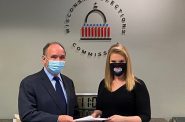Meth Epidemic Overwhelming Counties
Staggering increases in addiction. Help from state is needed.
![A glass pipe used for smoking methamphetamine with shards inside. Photo by Jlcoving (Own work) [CC BY-SA 3.0 (http://creativecommons.org/licenses/by-sa/3.0) or GFDL (http://www.gnu.org/copyleft/fdl.html)], via Wikimedia Commons](https://urbanmilwaukee.com/wp-content/uploads/2017/04/Methpipe.jpg)
A glass pipe used for smoking methamphetamine with shards inside. Photo by Jlcoving (Own work) [CC BY-SA 3.0 (http://creativecommons.org/licenses/by-sa/3.0) or GFDL (http://www.gnu.org/copyleft/fdl.html)], via Wikimedia Commons
“Our system just isn’t equipped to deal with the meth problem,” said another social worker.
Recently, more than 400 county supervisors and Health and Human Services staff came to the Capitol. I had visitors from every county in our Senate District. These officials brought me one clear message: Help us deal with the meth problem.
Dunn County officials told me about the increase in people entering treatment. Last September, 35% of those entering treatment were meth addicts and this number steadily grew. By February, 60% of those entering treatment were addicted to meth.
The county staff shared many stories about the impact of meth addiction on children. These children are exposed to the drug because addicts smoke the substance. The drug pollutes the air and surfaces of the home. All workers test children of meth addicts for exposure to meth
“We tested a four-year-old and a one-year-old,” said a social worker. “The two children tested higher than the average meth users.”
The social workers said they are struggling to fill the needs of so many youngsters ravaged by the addiction of their parents. Counties assess the child’s needs but as the county staff explained, it is difficult to tease out what is happening with a child.
Is a child suffering withdrawal symptoms because of second-hand drug exposure or suffering developmentally because of poor nutrition. Has the child experienced emotional or physical trauma? Certainly, the vast majority of children of meth-addicted parents suffer neglect.
A social worker told me that she visited a mom in jail who decided to voluntarily give up her child. The sorrowful mom told the social worker she wished she never did meth, because “it makes you forget you ever had children.”
Helping the large number of suffering children has stretched county budgets thin. The cases are hard. Social workers are difficult to find and often not trained to assist children from drug-troubled homes. Staff turnover is high.
For the addicts themselves, treatment programs are limited. Insurance only pays for a few days of inpatient treatment. To be effective, a meth addict must stay inpatient for at least a month. In my own research, I learned the brain takes at least a year to recover from some damage done by meth. Relapses are common, as is depression and other forms of mental illness.
Local sheriffs explained how their entire annual budget for transporting the arrested mentally ill person was gone in the first few months of this year because of so many new cases of mental illness and meth-induced violence.
“Opioid users go to the emergency room,” a human services manager told me. “Meth addicts go to jail.”
Lawmakers recently paid much attention to problems associated with heroin and opioid-related drugs. However, the epidemic in western Wisconsin is meth.
Counties need resources to help children who need safe homes. Our region needs treatment and emergency crisis centers. Long-term inpatient treatment is expensive but can be effective. Further, we must help those suffering from mental illness and keep them from turning to addiction instead of mental health treatment.
Lawmakers will soon take up a series of bills to combat heroin. I ask my colleagues to expand their awareness and consider the impacts of meth: on our children, our county budgets, the safety of our communities and the lives of the addicts.
In the spirit of rebirth, Easter and spring, I ask families affected by mental illness or drug addiction to get help. It is not easy. But there is hope.
State Sen. Kathleen Vinehout, D-Alma, is a member of the Wisconsin state Senate.
Op-Ed
-
Why Vote for MPS Funding Referendum
 Mar 30th, 2024 by Nehemiah Edwards
Mar 30th, 2024 by Nehemiah Edwards
-
Wisconsin’s Very Own Rudy Giuliani Should Not Oversee Judicial Ethics
 Mar 25th, 2024 by Richard Niess
Mar 25th, 2024 by Richard Niess
-
Voting at Wisconsin’s Universities Isn’t Easy
 Mar 17th, 2024 by Nicole Laudolff
Mar 17th, 2024 by Nicole Laudolff

















Wish they would have been talking like this during the crack epidemic during the 80’s. Now that rural white people are on the drugs the language turns into “let’s help these people” instead of “let’s lock up these degenerates”. There are solutions for these problems if our society decides that solving them is a priority.
“But there is hope.”
Ok. From where? Because it sounds like law enforcement is stretched thin. It sounds like the social workers are stretched thin financially and also suffer from high staff turnover. By the author’s own stats, some areas have seen four-fold increases in the number of cases.
So where is this “hope” coming from? The author is a State Senator….what is the Senate doing to give us “hope”? In fact, instead of giving us “hope”, dear Senator, how about using the power of the legislature to enact an actual solution or better fund those in law enforcement and social service that are actually out there trying to do something?
This is horribly destructive drug, wastes people away in year. Worked in Rehab for 40 years.
Bob Donal, Rph
Marna. talk to the dn governor of your state! You are right about the new emphasis on “working whites” being a large part of the concern with heroin. But that does not mean it is the whole story, There are counties in Appallachia making good money off those people. And the ones making it are not card carrying BLM of NAACP! Can you get my point?
SAMHSA has staaarted some experimental programs across the country to look at ending the prison in place of treatment issues. Jail is the most expensive option. But we are stuck there. Why doesnt matter as much as how to get unstuck. Focus.
Dear Sen VinehOUt, Seems I remember several meth epidemics. The late 60’s blossomed as hippy met Korean War addicts. Rural Nebraska was supplying fertiiizer via theft and the children were in the national press. Drugs right here in…”river city.” sort of headlines and disbelief. It happened before and after the crack epidemic. The ice epidemic we have now is nothing new, it is not half the extent of the use right now. it is nothing new in its impact or its demographics. Why do we never remember? why do we INSIST ON FORGETTING?